It’s been 80 years since VE Day. I was just four years old on May 8th in 1945, the day that marked the end of WW2 in Europe. Wartime is one way to concentrate the mind on essentials. Bread, for instance. Waste not, want not. As a war-baby born during the Blitz - just in time to meet my father, an airman lost in the waters of the North Atlantic, flying Lancasters out of Iceland to protect food-conveys from the US - at the end of WW2 in Europe.
I learned everything I know about recycling from my father’s mother, an Edinburgh-born Scot with firm views on absolutely everything, including potato-peelings, bacon-dripping and hens past their laying days. Eighty years on (give or take a year) I still save the ends of loaves to make breadcrumbs to crisp up as toppings when it’s a waste of heat to turn on the oven (always ensure a full oven) and keep butter-wrappers to line the cake-tin. And I don’t buy pulses in tins - why pay for water when you can soak your own, bag them up and shove ‘em (ready-cooked or not) in the freezer till you need ‘em.
To return to the matter in hand, how best to celebrate Victory in Europe Day but with an all-in vegetable pie fortified with cheese, as recommended by storecupboard-supremo Lord Woolton, inventor of Woolton Pie. His lordship was charged with persuading an island-nation - accustomed to import most of its foodstuffs from elsewhere (mostly meat, usually the colonies) - self-sufficient in staple foodstuffs that could be grown at home. The hero of his campaign, 'Potato Pete', a (theoretically lovable) cartoon character, encouraged an appetite for the only vegetable the nation didn’t consider vegetarian since it usually came with gravy. Another success was ‘Dig For Victory’, a nationwide campaign that persuaded a nation of gardeners to dig up and turn to good use every scrap of arable land available, including Hyde Park and the gardens at Buckingham Palace. The result was a diet of cabbages, carrots, leeks, parsnips, turnips, rhubarb, sprouts, onions, cauliflowers, beetroot and (reluctantly) spinach from which a meat-eating nation took a long time to recover. Nothing fancy, everything plain-boiled except on Sunday (with an exception for white sauce), certainly nothing that could be identified by name as foreign, such as broccoli and aubergines, let alone cavalo nero.
Government-issued recipe books instructed the nation’s housewives - already doubling-up as land-girls, factory-workers, ambulance drivers, top-secret code-breakers and (perish the thought) aircraft delivery-drivers - on the uses of dried milk and powdered eggs. Public catering facilities were set up to take the strain off the national larder. Factory workers took their main meal in the canteen while local authorities set up British Restaurants - state-run feeding-stations where ingredients could be measured and monitored (Ceacescu did the same in Romania under Communism). In the capital, mobile canteens dished up Blitz Stew, an all-in boil-up sufficeint to serve a hundred bombed-out residents when prepared with 100 lbs vegetables to 10 lbs meat plus 25 lbs of breadcrumbs and a pound of parsley to thicken the juices - all to be cooked, if circumstances demanded, in a scrubbed-out dustbin.
Meanwhile, the nation’s per capita intake was set at 3,000 calories per day (Germany allowed 2,600 for manual workers and far less for those judged unproductive). Absolutely nothing was to be wasted and leftovers used up as made-dishes (anything in white sauce or improved with Bisto gravy). And when you were altogether done with the cottage pie and the rissoles, the leftovers went feed the hens and fatten up the household pig (yours or the neighbours in exchange for a share of the bacon). My gran kept Rhode Islands Reds, possessive egg-layers with sharp beaks - and yes, there was a time when I did keep a household pig myself, when my children were young and we lived in the wilds of Andalucia and the neighbours kept a porker of the old Iberian breed to eat up the kitchen scraps, so the matter was non-negotiable.
Bombs fell on London every day and right through the night throughout the war years. Even now, eighty years on, I still remember loud noises as a reason to look sharp and drop under the table (a problem at dinner-parties on Fireworks Night). And I never buy skinless chicken-joints (why miss out on the stock-pot?), and persuade the butcher to add a chicken-carcass or two to a pound of sausages. And I always save onion skins to colour the broth from the stock-pot, and use the leavings in the breakfast teapot to de-glaze the roasting-tin (PG tips, since you ask) when roasting root-veg in olive oil, lemon and garlic for the vegetarian granddaughter. Waste not want not, said granny. And as usual, Granny was right.
Victory meat loaf
A frugal wartime dish from my Edinburgh granny's household book. The recipe may be a little heavy on the breadcrumbs, but it does include a fresh egg (the allowance was one a week per person). As an airman's wife living in officer's accommodation with a small back garden, she kept chickens throughout the war years (and long afterwards). The smell of chicken mash - mostly stale-bread and carrot-scrapings puffing away on the back of the stove - is one of my most enduring childhood memories. Meat loaf was the Sunday treat.
Serves 4
1 cup (8 oz/250g) minced pork or sausage-meat
3 cups (8 oz/250g) wholemeal breadcrumbs soaked in cider or apple-juice
2 tablespoons chopped parsley
4 onions or leeks, skinned and finely chopped
1 (treasured) egg
1/2 teaspoon ground pepper
1/2 teaspoon grated nutmeg
1/2 teaspoon powdered sage
1/4 teaspoon powdered bayleaf
1 teaspoon salt
Mix all the ingredients thoroughly. Press the mixture into a greased loaf-tin of the size suitable for the Grant Loaf (see below).
Bake at 375F/190C/Gas 5 for an hour, basting with more cider or apple juice to keep the loaf moist. Nothing to it, really. Serve with baked potatoes (dripping optional) and home-made mustard - whole-grains crushed and mixed with dry cider or gooseberry juice.
The Grant Loaf
Doris Grant, founding-mother of the safe-food movement in the 1950’s, published her famous recipe for a whole-meal no-knead loaf suitable for women in the workplace and unable to spend time in the kitchen during WW2. I’ve left the recipe in the form of ounces and pounds - kilos and grams would have been unthinkably foreign at the time.
Makes 3 x 2 lb loaves
3 lb stone-ground wholemeal flour
2 tsp salt
3 tbsp warm water (blood-heat)
3 level tsp dried yeast
3 rounded tsp dark brown sugar or honey or black treacle
2 pints warm water (blood heat)
First, set ready your loaf tins, well-greased.
In a roomy bowl, warm the flour a little in a very low oven - or set it out in the summer sunshine - and mix in the salt. In a small bowl, mix the 3 tbps warm water with the yeast and whisk till completely dissolved. Whisk in the sugar or honey or treacle. Leave to froth - it’ll take about 15 minutes.
Pour the frothy liquid into a well in the flour and add the second measurement of warm water. Mix to a dough with the hook of your hand. Work it till smooth and elastic enough to leave the sides of the bowl - don’t worry if it’s still a bit sticky.
Divide into 3 equal pieces, knead each piece into a fat little bolster, tucking the seam underneath, and transfer to the loaf tins. Cover with a clean cloth and eave to rise for 30 minutes in a warm draught-proof corner.
Preheat the oven to 400F/200C/Gas6.
Bake for 40 minutes till the loaves are well-risen and brown. Tip them out of the tin and give the base a tap. If it sounds hollow, the bread is ready. If not, pop the umoulded loaves back in the oven for another 5-10 minutes.
P.S. Beloved paid-subscribers will shortly be in receipt of Alice B. Toklas’ wartime recipe for Raspberry Flummery and Miss Monica Rawlins’ deliciously moist Steamed Chocolate Cake (no need for an oven in wartime). Pip pip!


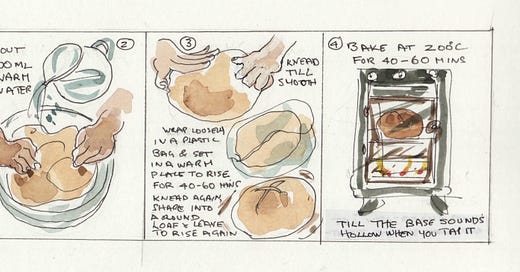



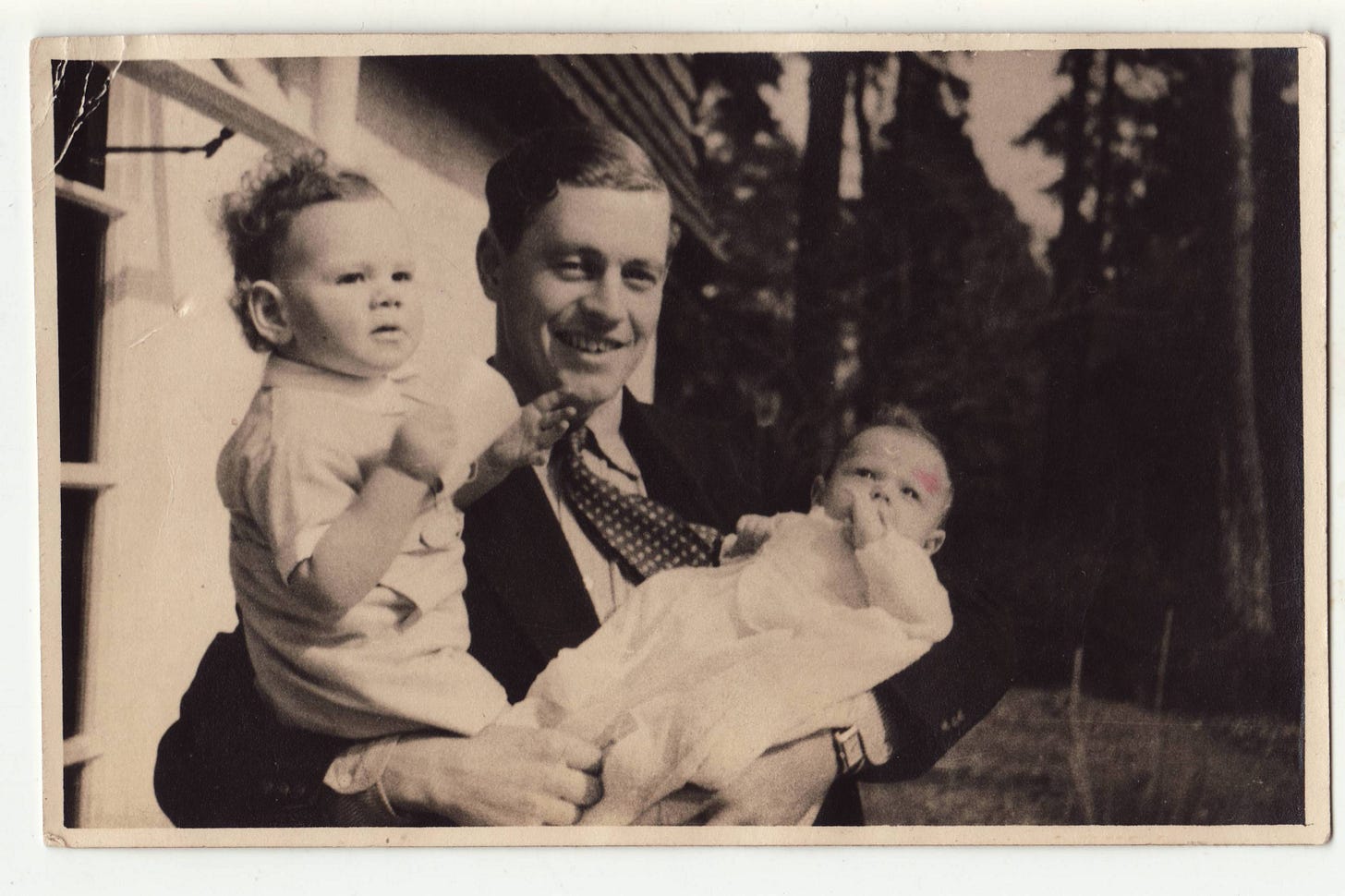
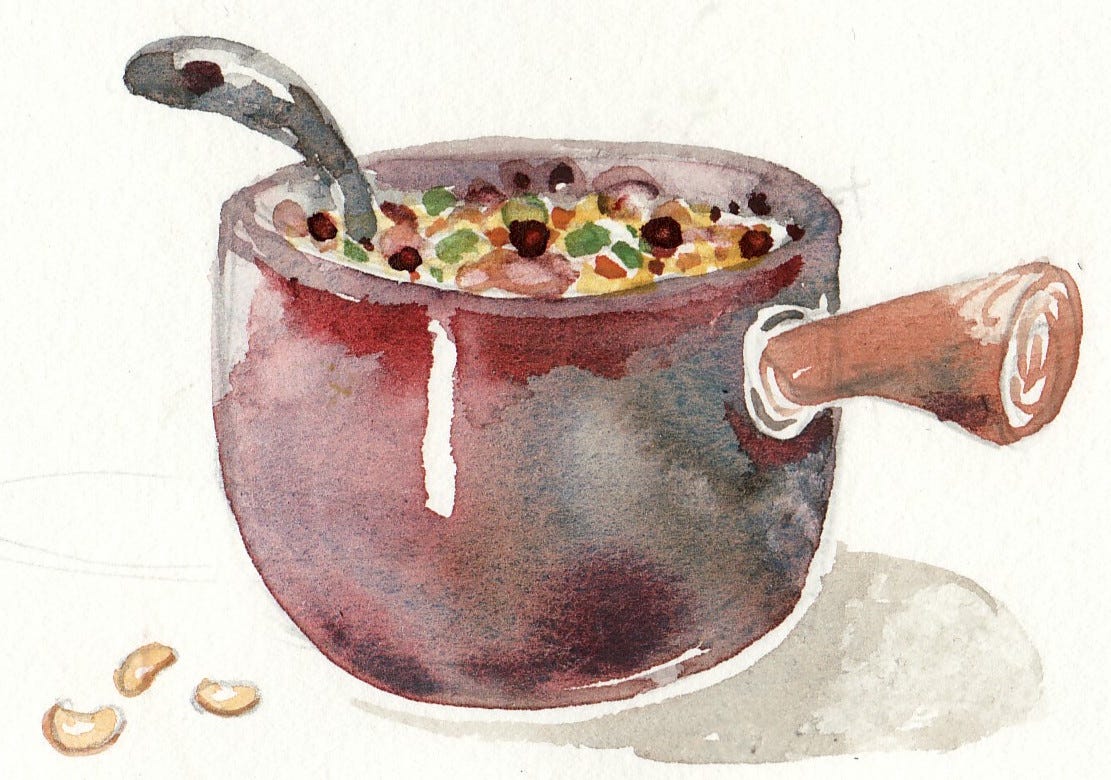
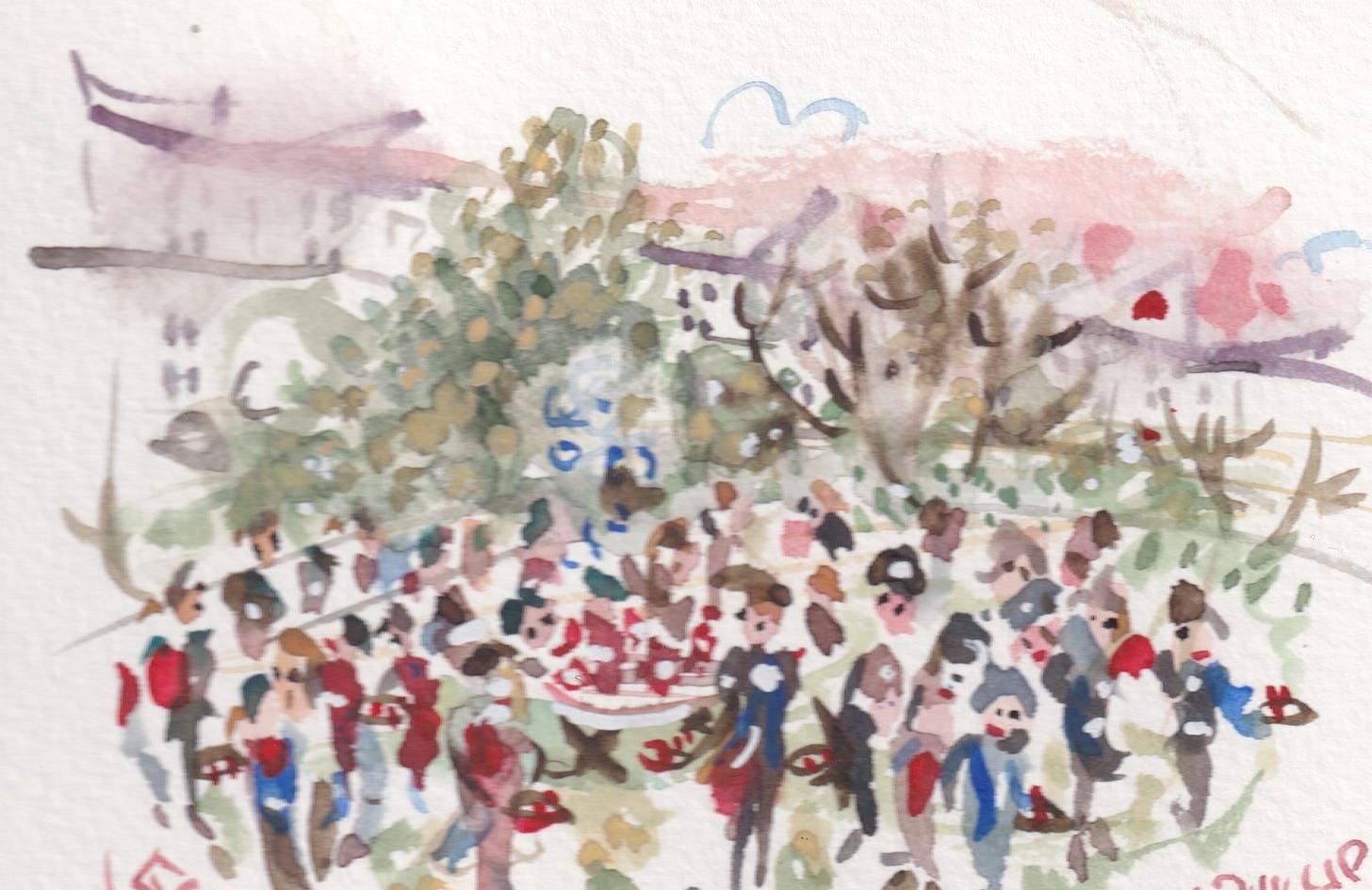
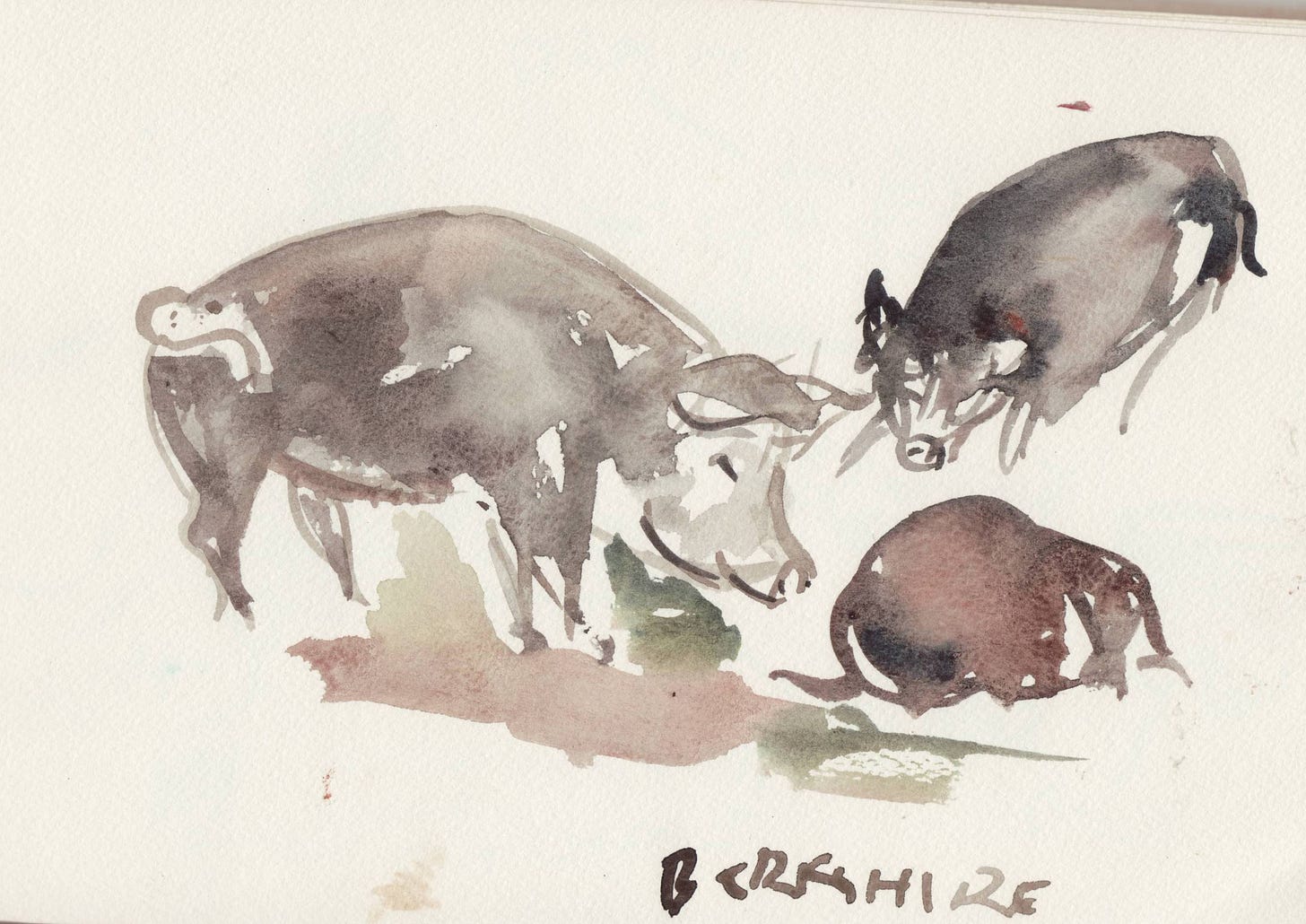
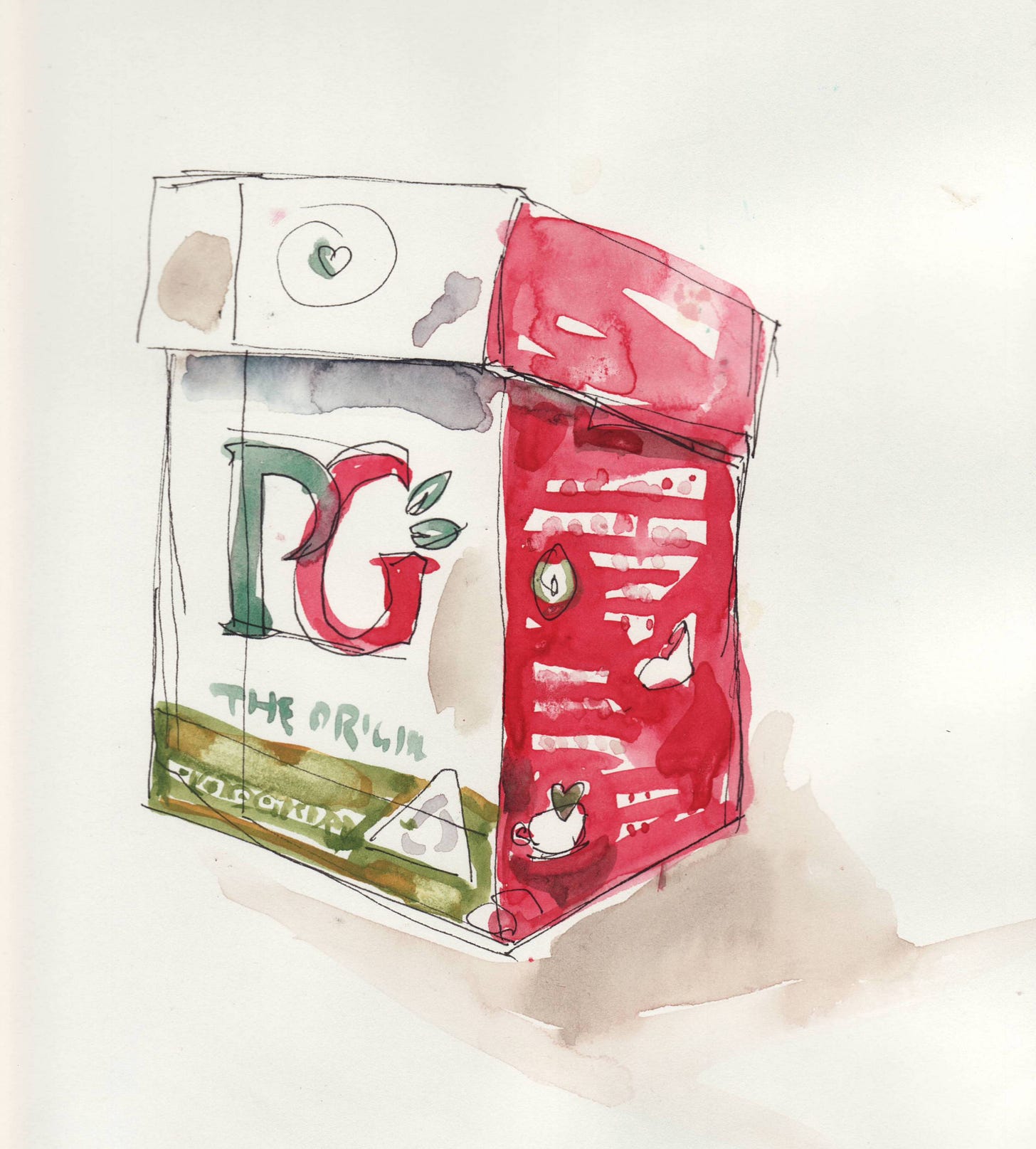
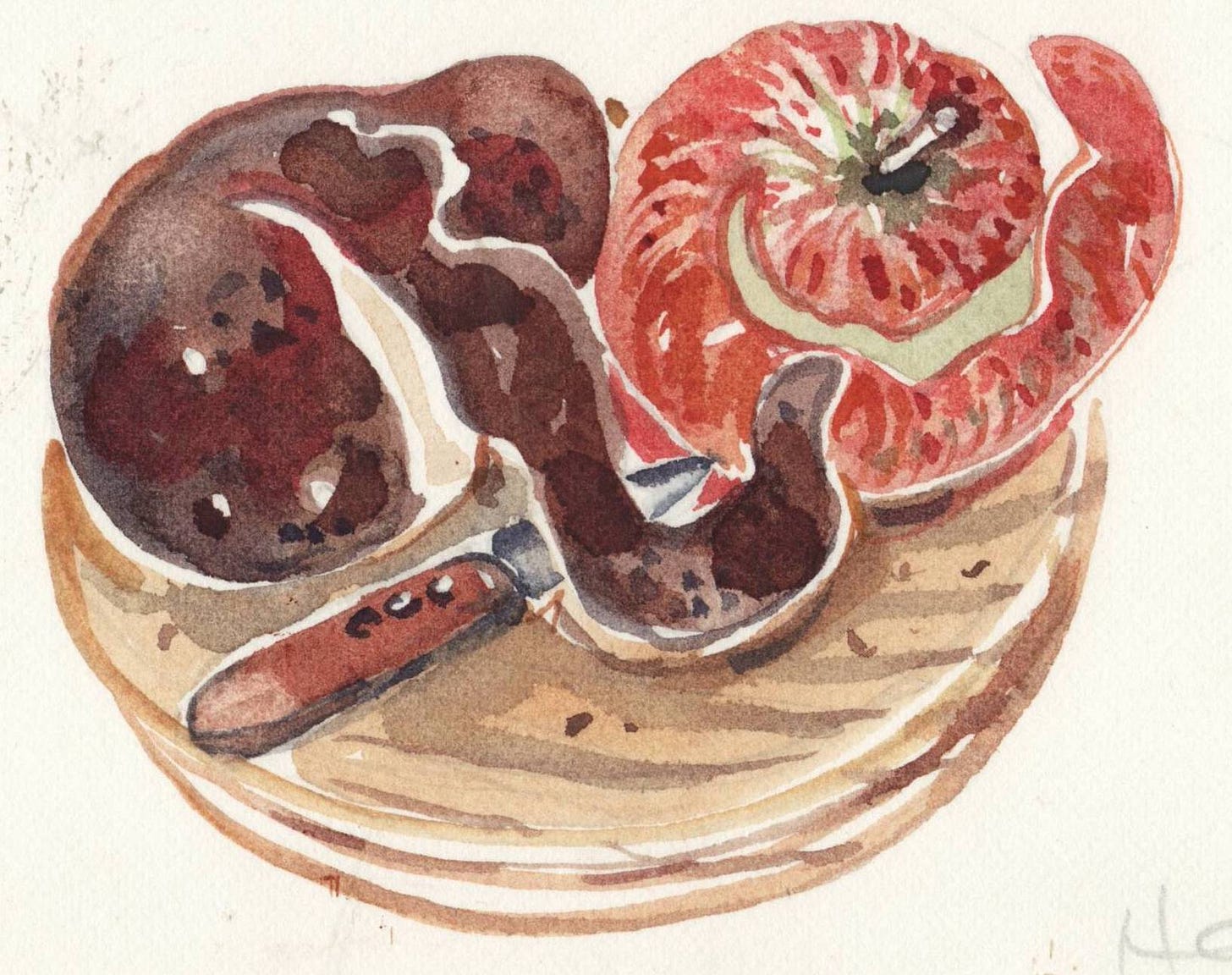

Marvelous. The bread sounds delicious if, as you say, rather dense, could you let it rise for longer? Also, dividing by half quantities, can you use instant yeast? Or change other measurements? I am not a bread baker, or indeed any description of a baker, but now find it almost impossible to find 100% wholewheat bread. Guess I'll have to try this rationing staple, but need advice...
How wonderful and moving recipes! and your watercolors are stunning, as always!!!